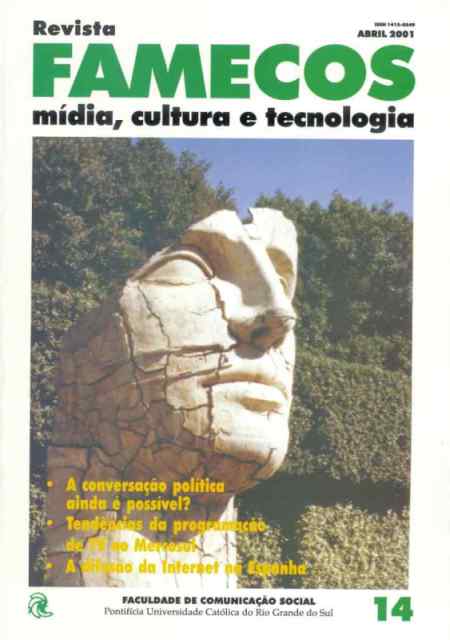The diffusion of the Internet: sociological profile of the Spanish adopter
DOI:
https://doi.org/10.15448/1980-3729.2001.14.3101Keywords:
Broadcasting, Computer Mediated Communication, Internet UsersAbstract
The main purpose of this work is to distinguish the different profiles of Internet users in Spain. The methodology suggested by Everett M. Rogers leads to the establishement of five main categories of people regarding their process of acceptance of a new technology. The empirical application is carried through a sample of both actual and potential users of Internet in Spain. To differentiate peopleʼs behaviors according to each category, the study uses the technique of segmentation analysis.
Downloads
References
AICM, EGM, Encuesta sobre usuarios de Internet, 1997.
ALBA, R. D., y KADUSHIN, CH. The introduction of so ci al circles, A new mesure of social proximity in networks. In: Sociological Methods and Research, v. 5, 1976.
BELL, D. El advenimiento de la sociedad postindustrial. Alianza: Madrid, 1976.
BERGER, P. et. al. Freedom and Control in Modern Society. Nueva York: Octagon, 1964.
BOSE, S. The difusion of a Farm Practice in Indian Villages. In: Rural Sociology, v. 29, 1964.
CASTELLS. M., El desafío tecnológico. España y las nuevas tecnologías. Madrid: Alianza, 1986.
CASTILLA, A.. Impactos de la sociedad y su evaluación. La cultura, la empresa y el nuevo orden mundial, Sociedad de la Información: 1992, ¿un año de reflexión?, Simo, 16 de noviembre 1992. Diccionario de Sociología Larousse. Barcelona: Larousse Planeta, 1995.
ESTUDIO CIS. In: Tiempo Libre e Informática, n. 2269, 1998.
GRANOVETTER, M., Threshold Models of Colllective Behavior. In: American Journal of Sociology, 1983.
GUTIÉRREZ, A. Ciencia y cambio tecnológico en España. Madrid: Fundación 1° de Mayo, 1990.
R. SILVERSTON Y E. HIRSCH (eds.). Los efectos de la nueva comunicación: el consumo de la moderna tecnología en el hogar y la familia. Barcelona: Bosch Comunicación, 1996.
JOYANES, L. Cibersociedad: los retos sociales ante un nuevo mundo digital. Madrid: McGraw-Hill, 1998.
LORENTE, S., y cols. Tecnologías para la Información: La convulsión de la década. In: V Informe sociológico sobre la situación social en España, Foessa, Madrid, 1995.
MASON, R. The use of Information Sources by Influentials in the Adoption Process. In: Public Opinion Quarterly, v. 27, 1963.
OLIVER, P., MAXWELL, G., y TEXEIRA, R. A Theory of Critical Mass: Interdependece, Group Heterogeinity, and the Production of Collective Action. American Journal of Sociology v. 91, 1985.
OLSON, M. The logic of collective action: Public Goods and the Theory of Groups. Harvard University Press, 1965.
ROGERS, E. Difussion of Innovations. Nueva York :The Free Press, 1983.
RYAN, B. A Study in Technological Difussion. In: Rural Sociology v. 13, 1948.
Downloads
Published
How to Cite
Issue
Section
License
Copyright
The submission of originals to Revista Famecos implies the transfer by the authors of the right for publication. Authors retain copyright and grant the journal right of first publication. If the authors wish to include the same data into another publication, they must cite Revista Famecos as the site of original publication.
Creative Commons License
Except where otherwise specified, material published in this journal is licensed under a Creative Commons Attribution 4.0 International license, which allows unrestricted use, distribution and reproduction in any medium, provided the original publication is correctly cited.






